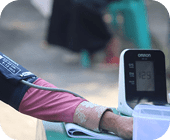Black communities are more than twice as likely to be diagnosed with this condition. Raising awareness is critical, because early detection can protect quality of life and improve survival.
Multiple myeloma is a type of cancer that starts in plasma cells – a kind of white blood cell that helps fight infections. In people with myeloma, these cells become cancerous and multiply in the bone marrow, crowding out healthy cells and damaging bones, kidneys, and the immune system.
This condition is rare, but Black Americans are more than twice as likely to be diagnosed with it, often at younger ages and with more aggressive forms. Despite this, we’re less likely to be diagnosed early, included in research, or offered cutting-edge treatment options.
Early multiple myeloma symptoms can be vague and easy to overlook. Common signs include:
BONE PAIN
FREQUENT INFECTIONS
UNEXPLAINED WEIGHT LOSS
Because symptoms can mimic other conditions, it’s important to advocate for blood tests and imaging if something doesn’t feel right.
Living with asthma? Our community member, Eriel, knows a thing or two about managing flare-ups or asthma attacks. In this video, Eriel talks about:


Here are a few factors that might put you at risk for multiple myeloma:

While there’s no cure yet, there are powerful treatments available, and Black people deserve full access to them.




Here are a few ways to prevent breast cancer:


If detected early, it is easier to prevent breast cancer from spreading to other parts of the body. Getting regular screenings (mammograms) is one way to help detect and treat the disease early.

Diabetes is another leading cause of CKD. If you have diabetes, carefully monitor your blood sugar levels and follow your doctor’s recommendations to keep them in a healthy range.

Getting a mammogram every year starting at age 40. A mammogram is a special X-ray that checks for breast cancer by taking pictures of the inside of your breast and can catch about 85% of breast cancers in women.

If detected early, it is easier to prevent breast cancer from spreading to other parts of the body. Doing a monthly breast exam on yourself is one way to help detect and treat the condition early.
We read the online discourse on multiple myeloma and found that our community is looking for:

Multiple myeloma is a complex condition, posing significant challenges due to its varied and subtle symptoms. Many people experience no distinct symptoms and are unaware of the symptoms to look out for, allowing the condition to go undetected.
One significant hurdle is the limited availability of specialists, particularly in certain geographic areas, which can necessitate long-distance travel and potentially high associated costs. This geographical challenge often means people wait weeks for an appointment, which adds to their stress and delays treatment.
The underrepresentation of Black people in multiple myeloma clinical studies is a critical issue. A notable 24% of Black people are deemed ineligible for these studies, often due to strict criteria that do not account for our genes, such as the Duffy-null phenotype, which is more common amongst the Black community.
Dealing with insurance for multiple myeloma treatment can be an overwhelming journey for people. Stories from people living with the condition, who hit their out-of-pocket maximum quickly due to the steep costs of multiple myeloma treatments shows the importance of understanding insurance plan specifics, such as how plan selections affect total treatment expenses.
Multiple myeloma is a complex condition, posing significant challenges due to its varied and subtle symptoms. Many people experience no distinct symptoms and are unaware of the symptoms to look out for, allowing the condition to go undetected.
One significant hurdle is the limited availability of specialists, particularly in certain geographic areas, which can necessitate long-distance travel and potentially high associated costs. This geographical challenge often means people wait weeks for an appointment, which adds to their stress and delays treatment.
The underrepresentation of Black people in multiple myeloma clinical studies is a critical issue. A notable 24% of Black people are deemed ineligible for these studies, often due to strict criteria that do not account for our genes, such as the Duffy-null phenotype, which is more common amongst the Black community.
Dealing with insurance for multiple myeloma treatment can be an overwhelming journey for people. Stories from people living with the condition, who hit their out-of-pocket maximum quickly due to the steep costs of multiple myeloma treatments shows the importance of understanding insurance plan specifics, such as how plan selections affect total treatment expenses.
Many people with multiple myeloma live active, fulfilling lives. Explore the resources below.
Real people share how they manage their diagnosis—and stay encouraged.
Questions to ask at your next visit, especially if you’re experiencing symptoms.
Local events for multiple myeloma education may be closer than you think. Watch the recap from our latest event in LA.
Over 100K community members across the US are making a difference in their health. Are you ready to take action?
Already part of the community? Login here.
